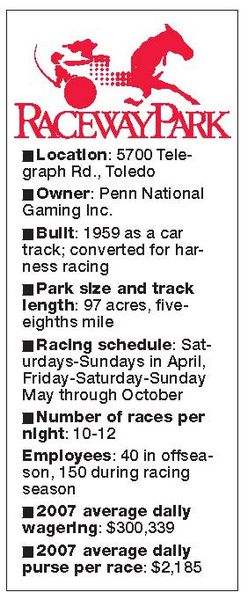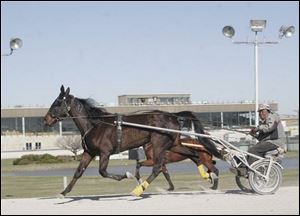
Rising costs, lower prizes restrain Ohio racing
4/20/2008

Roy Hunter exercises a horse at Raceway Park. Horse owners say the rise in other forms of gambling has hurt their industry.
KAREN TKACZYK glanced at an adjacent stall and a horse within, then at the nearby Toledo Raceway Park when asked about her future in raising and training standardbred harness race horses.
"I think there will be a lot of changes, a lot of changes," said Ms. Tkaczyk, her clothes, helmet, and parts of her face spackled with dust from a training ride completed moments earlier one morning last week.
But Ohio's harness racing industry, which some estimate at $750 million in annual revenues and about 16,000 jobs, has gone through myriad changes, few of them positive.
The industry is getting hammered by a two-pronged attack: the rise of Internet gaming and the growth of casino gambling in the surrounding states of Michigan, Pennsylvania, West Virginia, and Indiana.
"It's at the point where many are asking: 'Can the business sustain itself on its own or is the property itself more valuable?'•" said Bill McLaughlin, Raceway Park general manager.

The decline began about 10 years ago, with the growth of the Internet, as figures by the Ohio State Racing Commission readily attest.
The total amount of wagers placed on races at the state's four commercial harness tracks, three thoroughbred tracks, and county fairs' tracks dropped from $629 million in 1998 to $372 million last year.
At Raceway Park, owned by Penn National Gaming Inc. and located at 5700 Telegraph Rd. near Alexis Road, the wager figures dropped from $51 million to $30 million in the same time period.
In comparison, the state of Oregon, which allows Internet-based gaming and wagering on horse races across the United States, licensed two companies to provide such service in 2000. The companies had wagers of $18 million that year. Last year, the state had nine licensed companies with wagers of $1.5 billion.
Even more important than the wagers, money in Ohio for purses - the cash awarded to the winners of each race - has dropped from a high of nearly $20 million in 2001 to just $12.9 million last year.
Purse money is what makes horse breeders, trainers, and drivers compete. As purses dwindle, more breeders are apt to sell their foals to out-of-state stables, and trainers and drivers to relocate to more lucrative tracks.
"I've known a lot of owners who've gone elsewhere. Some just got out altogether," said Ms. Tkaczyk, owner of Tkaczyk Racing Stables of Toledo.
With a bag of grain for the horse rising from $4 to $12 now and a bale of hay increasing from $1 to $4, plus higher fuel costs to transport horses from track to track, owners' expenses have became an issue in the past year, Ms. Tkaczyk said.
"If we could just get another $300 or $400 more a purse, we could make it," she added.
Kim Marts, whose husband Tom has trained and raced horses at Raceway Park for 30 years, said it is a shame how quickly things went downhill.
"A lot of people are trying to stick it out, but I don't know how many will," said Ms. Marts. She is the Ohio Harness Horsemen's Association representative to Raceway Park.
Harness racing has a rich history in the state. Delaware, Ohio, is home to one of the industry's most prestigious races, the Little Brown Jug.
"Harness racing has a very positive economic impact in the state. But there's no question that the industry at this point is suffering an economic malaise because of the competition that's involved in the gambling industry, and also where you have surrounding states with gambling industry," said Ohio State Racing Commissioner Jerry Chabler, of Sylvania.
Would-be customers go to other states to gamble instead of coming to the racetrack, and Internet gambling takes millions of dollars from the Ohio tracks and from state tax revenue, he said.
Ohio law forbids casino-style gambling, such as slot machines and card and table games.
Referendums to allow it have been consistently voted down.
Meanwhile, track owners make do solely with the profits they get from those attending the races. Mr. Chabler said something needs to be done or some tracks may be out of business.
Attendance at harness and thoroughbred racing in other states has dwindled, as has betting.
Several of those states, such as Indiana, Pennsylvania, and West Virginia, have voted to allow race tracks to install alternative gaming, including slot machines and video poker, to subsidize purses and salvage their flagging race tracks. Ohio recently defeated such a measure.
Jerry Knappenberger, general manager of the Ohio Harness Horsemen's Association, said breeders in Pennsylvania now get some money from the slots, and two new tracks are under construction in the state, even though racing itself is not as popular. The tracks are being built because they can offer slots and other alternative gaming.
Purses are now sometimes above $200,000 near Philadelphia, but the amount is $20,000 at Toledo's park, he said. "We can't compete with that."
Ohio's horse industry also is dwindling, Mr. Knappenberger said.
For years, Ohio was the top state for breeding of standardbred mares, but those numbers have recently slipped. Ohio fell to sixth in 2007 with just 1,261 mares, compared with 1,997 mares bred in 2006.
Some breeders are sending their mares out of state or going out of business, he said.
John McNamara, marketing director at Raceway Park, said his track and other sites stay in business because their owners are willing to take the losses. That's because they hope the tracks will be allowed to have slot machines and other forms of gambling, he added.
"They understand that it is going to take time," he said.
Mr. Chabler said the state's position on allowing slot machines at racetracks could change, but the tracks "have to come up with a better way of doing things, they have to be a lot more innovative than they have in the past."
Raceway Park is leading the way, said Mr. Chabler and Mr. Knappenberger.
Penn National, which owns casinos in several states, acquired Raceway Park in 2005 by buying the track's owner, Argosy Gaming.
In an attempt to boost the track's revenues, Penn hired Mr. McNamara to find ways to attract customers.
Penn has also invested nearly $2 million in renovations.
Mr. McNamara said the aging site got its first coat of paint in recent memory, restrooms were upgraded, and food service was improved to include buffets.
Raceway began bringing in live bands, had promotional giveaways, and is working to upgrade its paddock area next to the track.
It also opened a new customer services desk and has tried to improve its relationship with horse owners and trainers.
The results were immediate.
Raceway Park, which opened a week ago for its season that runs through October, had an opening week attendance increase of 26 percent, and its opening week wagers jumped 59 percent.
It drew about 1,200 people on its first Saturday, compared with a previous average crowd of about 600.
Rather than competing only for traditional horse racing enthusiasts, Raceway Park will try to market itself as an entertainment venue for all, Mr. McNamara said.
"Really, other than the Mud Hens, there isn't a lot to do around here in the summer," he said. "We'll apply some marketing efforts to a younger crowd and offer this as a unique experience."
Contact Jon Chavez at:
jchavez@theblade.com
or 419-724-6128.